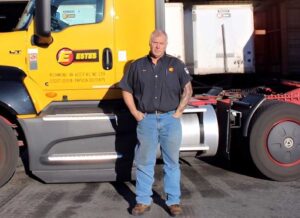Throughout the two years of the COVID-19 pandemic, North America’s transportation companies have steadfastly upheld the old tagline of “Keep on Truckin’” — delivering the goods and supplies to sustain those locked in their homes and wondering what the future held.
Now, however, the industry COVID couldn’t stop is finding itself increasingly stalled by a lack of parts needed to build new rigs and keep existing ones running.
“We’ve experienced some parts and components challenges in years past, but I don’t know that at any time it’s been to the level that we are currently seeing, or to the amount of different parts that we’re seeing today,” said D.M. Bowman, Inc. President and 30-year industry veteran Jim Ward. Ward is immediate past chairman of the Truckload Carriers Association (TCA) and is leaving D.M. Bowman to become president of TCA.
“It’s across the board,” he explained. “It’s not only components for the tractors, like the various temp sensors and speed sensors. Tires are a problem for all the suppliers. Even oil; we deal with one major oil supplier, but we’re buying oil right now from anybody.”
The current parts crunch, which has affected every category of wheeled vehicle, was initially set off by the pandemic in 2020, but has no shortage of contributing factors. Some analysts point to semiconductor chip shortages, others to manufacturers of mechanical parts that are still struggling to ramp production to pre-COVID levels.
Heavy Duty Manufacturers Association (HDMA) then-President and COO Dave Giroux described the scope of the problem in a blog post in October.
“Our data highlights how the ongoing situation has permeated all HDMA-member companies,” he shared. “Member companies have reported shortages of componentry including semiconductors, steel, plastics, aluminum, rubber, and a variety of commoditized goods necessary in the manufacture of commercial vehicles.
“However, it is important to note that HDMA members say the supply chain problems are not just a function of inaccessibility of parts,” he continued. “The situation is unique and is comprised of lack of materials, the unavailability of freight and logistics — which is leading to widespread, lengthy, and sustained delays for both inbound goods and outbound shipments — labor shortages, and the inaccuracy of production and demand forecasts.”
TCA Profitability Program (TPP) Managing Director and Phoenix-based GPorter Group President Jack Porter lays much of the blame for longer wait times and higher prices at the feet of the nation’s continuing worker shortage.
“Shippers and carriers have developed a supply chain solution where drop trailers are a key component of expediting freight and keeping drivers moving,” he said. “The logistics problem boils down to manpower — people to load and unload these trailers expeditiously so that drop trailers are emptied and refilled for the carrier to execute the drop and hook strategy.
“Many carriers are seeing shippers low on manpower and space for completing their part of the equation, leading to inefficiencies and higher costs for carriers to complete the transaction. Simply put, we need people,” he added.
The current supply chain snarls are simultaneously impacting both new truck production and the OEM repair market, aggravating the situation from both ends. Fewer new trucks delivered means that older trucks are staying on the road longer. An increased number of older trucks on the road means more frequent breakdowns, with delayed repairs due to the parts situation.
That’s a particularly vicious cycle for a company like D.M. Bowman, which since its founding in 1959 has grown to a fleet of 380 trucks and seven locations predominantly east of the Mississippi, five of which are full-service maintenance facilities. The corporate presence in Maryland also includes a trailer shop and a body shop and the company also sells its own line of equipment.
“We’re pretty much self-contained, and we also offer maintenance service to many other motor carriers,” said Ward. “What we do on our equipment is preventative maintenance while providing the capacity to do work for other outside carriers.”
Ward added that the parts situation, which has yet to crest, is so severe it’s starting to affect other areas of operations outside of current hauling and service work.
“We’re in a business where up time and reliability are extremely important in servicing our customers,” he said. “But it’s probably even more important today for our commercial truck drivers from a retention perspective. I would take 60 drivers tomorrow if you could drop them off at my doorstep, but they want dependable equipment and want to work for a company who efficiently plans and executes their preventive maintenance.
“This parts and components issue, it just continues to be a moving target,” noted Ward. “Availability from week to week changes, and when you’re having these parts challenges, it can wreak havoc both on your customer relationships from an uptime perspective and reliability, and also to your commercial drivers with downtime.”
Solutions to the current problem are hard to come by in the industry, especially on the labor end. Porter said as refined as distribution networks and manufacturing technology have become, without people to feed them, the system is stuck in neutral.
“You can’t work-from-home to build or repair a truck. It’s a matter of being able to have people who are going to do that work,” he stated. “I really believe, on the supply side of the raw materials, we’ve gone through that before, and I think we’ll fix that. But this idea of A) trying to get people to work and B) what do we have to pay them to come into our industry, and then C) what is the impact of that going to be on the actual price of parts in the marketplace — those are the real questions.
“I’ve been around the dealership business and the trucking business since 1979, and I don’t remember any kind of chronic problem like we have now. This is not temporary in my mind,” shared Porter.
Ward agreed that the underlying issues are multi-tentacled, while noting the trucking industry has always been resourceful when it comes to meeting challenges. That has only intensified since the onset of COVID.
“We had a company here last week in our local area who literally called us because he couldn’t get any fuel filters,” he said. “He told us, ‘Look, I’ve got some ordered, but I don’t know when I’m going to get them.’ We said we’d give him some and when he got his in, he could get them back to us; we didn’t want to sell them to the guy. Lo and behold, a few days later he got in an order of fuel filters, and we got what he’d borrowed back. That’s the world we’re living in now.”
Listening to him tell the story, it’s clear Ward considers this sort of neighbor-helping-neighbor camaraderie satisfying. But you can also tell he’d like to see light at the end of the tunnel, something that has yet to come into view.
“You talk to the general public and most people outside of our industry know there is a parts shortage and all they’re talking about is the chips,” he said. “Yeah, the chip shortage has certainly disrupted heavy-duty truck production on new equipment, but the issue expands beyond semiconductors. Most people outside of our industry, I don’t think they realize that.
“I think things started to improve towards the end of last year as we all kind of worked through this process, and we all hoped this would be in our rearview mirror by now, but that’s certainly not the case. We’re still a long way off, I believe, from this issue coming back to some reasonable level of normalcy,” concluded Ward.
Dwain Hebda is a freelance journalist, author, editor and storyteller in Little Rock, Arkansas. In addition to The Trucker, his work appears in more than 35 publications across multiple states each year. Hebda’s writing has been awarded by the Society of Professional Journalists and a Finalist in Best Of Arkansas rankings by AY Magazine. He is president of Ya!Mule Wordsmiths, which provides editorial services to publications and companies.














